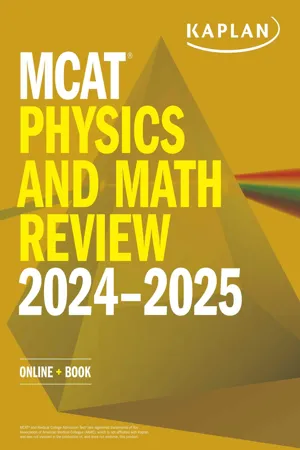Physics
Terminal Velocity
Terminal velocity is the maximum velocity that an object can reach when falling through a fluid, such as air or water. At this point, the force of air resistance is equal to the force of gravity, resulting in a constant velocity. The terminal velocity of an object depends on its mass, size, and shape.
Written by Perlego with AI-assistance
Related key terms
3 Key excerpts on "Terminal Velocity"
- No longer available |Learn more
MCAT Physics and Math Review 2024-2025
Online + Book
- (Author)
- 2023(Publication Date)
- Kaplan Test Prep(Publisher)
For now, we will assume air resistance to be negligible, meaning that the only force acting on the object would be the gravitational force causing it to fall. Consequently, the object would fall with constant acceleration—the acceleration due to gravity (g = 9.8 m s 2) —and would not reach Terminal Velocity. This is called free fall. Under these conditions of a free-falling object that has not reached Terminal Velocity, which are typical for Test Day, we could analyze the fall, using the relevant kinematics equations. Example: A ball is thrown vertically up into the air from a window ledge 30 meters above the ground with an initial velocity of 10 m s. Find the velocity and position of the ball after two seconds. Find the distance and time at which the ball reaches its maximum height above the window ledge. Solution: Remember that velocity and acceleration are vector quantities. For this question, let’s call the ball’s initial position, y 0, zero. If we consider up to be positive, then the initial velocity, v 0, is + 10 m s, and the acceleration, g, is − 9.8 m s 2. Note that g is negative because it’s oriented downward. Velocity after two seconds can be found using Equation 1.18: v = v 0 + a t = + 10 m s + - 9. 8 m s 2 2 s = 10 m s - 19. 6 m s = - 9. 6 m s After two seconds, the position of the ball is found using Equation. 1.19: y = v 0 t + a t 2 2 = (10 m s) (2 s) + (− 9.8 m s 2) (2 s) 2 2 = 20 − 19.6 = 0.4 m (above the ledge) When the ball is at its maximum height, the velocity, which has been decreasing on the way up, is now zero. We can find the maximum height the ball reaches using Equation 1.20: v 2 = v 0 2 + 2 a y 0 2 = (10 m s) 2 + 2 (− 9.8 m s 2) (y) 19.6 y = 100 y ≈ 5 m (actual = 5.1 m) The time at which the ball reaches its maximum height can be found from Equation - eBook - ePub
Doing Physics with Scientific Notebook
A Problem Solving Approach
- Joseph Gallant(Author)
- 2012(Publication Date)
- Wiley(Publisher)
Eq. (4.13b) becomes(4.19)where v is the (positive) magnitude of the (vertical) velocity vector. As the object moves faster, its acceleration decreases. When the object reaches Terminal Velocity its acceleration is zero.(4.20)When the object’s speed is vT , its acceleration is zero and it continues to fall at that constant velocity.Figure 4.4 shows the vertical speed as a function of time for an object dropped from rest (vox = 0) with and without air resistance.Terminal VelocityFigure 4.4With no air resistance, the speed increases linearly with time. With air resistance, the falling speed approaches Terminal Velocity.A tale of two trajectoriesFigure 4.5The plot uses k = 1/5s (which is about the baseball value) so the Terminal Velocity is approximately vT = 49 m/s.Trajectory
When we ignored air resistance, the calculation to find the trajectory was relatively easy and straightforward. Now the equations are more complicated, but the basic ideas are the same. Use Solve Exact and Eq. (4.17a) for the x-coordinate to find the time.Now Substitute (with Evaluate ) the time into Eq. (4.17b) for the y-coordinate, and then Simplify in-place the second term and Expand in-place the argument of the natural logarithm.We can edit this result by-hand and put the trajectory in a more standard form. Here is the trajectory in terms of the magnitude and direction of the initial velocity.(4.21)This is not the equation of a parabola!The expression analogous to Eq. (4.8) for the range of the projectile under the influence of linear air resistance cannot be expressed in terms of elementary functions. If you try to find the range with Solve Exact and Eq. (4.21) , SNB cannot find an algebraic solution.Even so, we can find the range for particular problems using Eq. (4.21) and Solve Numeric - eBook - ePub
- Laurie Ann Callihan, David Callihan(Authors)
- 2013(Publication Date)
- Research & Education Association(Publisher)
2 , the velocity will be 32 ft/s (9.8 m/s) after one second. Because the object is accelerating, the velocity after 2 seconds will be 2 s × 32 ft/s/s = 64 ft/s (19.6 m/s). After 10 seconds, the velocity will be 10 s × 32 ft/s/s = 320 ft/s or 98 m/s.Although a falling object will continue to accelerate until it is made to stop (when it hits the ground), air resistance will slow down that acceleration. Air resistance is approximately proportional to the square of the velocity, so as the object falls faster, the air resistance increases until it equals the force of gravity. The point at which these forces are equal is called its Terminal Velocity. For instance, a falling baseball reaches 94 miles per hour or 42 meters/second; it would remain at that velocity and no longer accelerate. A penny dropped from a high building will accelerate until it reaches around 230 mph.The acceleration of the force of gravity on falling bodies is independent of the mass of the falling object. Therefore, a 15-pound weight would fall at the same rate as a 2-pound weight and would hit the ground at the same time if dropped from the same height. In addition, gravity of the mass of an object is also independent of the velocity of the object parallel to the ground. For example, two bullets are positioned at the same initial height. One is shot from a gun horizontal to the surface. The other bullet is dropped at the exact same time as the bullet is fired from the gun. Both bullets will hit the ground at the exact same time, if no incidental air resistance or friction exists.F = maSince force = mass times acceleration, the universal gravity equation implies that as objects are attracted and get closer together, the force increases and the acceleration between them also increases.CLASSICAL MECHANICSMechanics is the study of things in motion. Classical mechanics involves particles bigger than atoms and slower than light. Newton’s Laws of Motion
Index pages curate the most relevant extracts from our library of academic textbooks. They’ve been created using an in-house natural language model (NLM), each adding context and meaning to key research topics.


